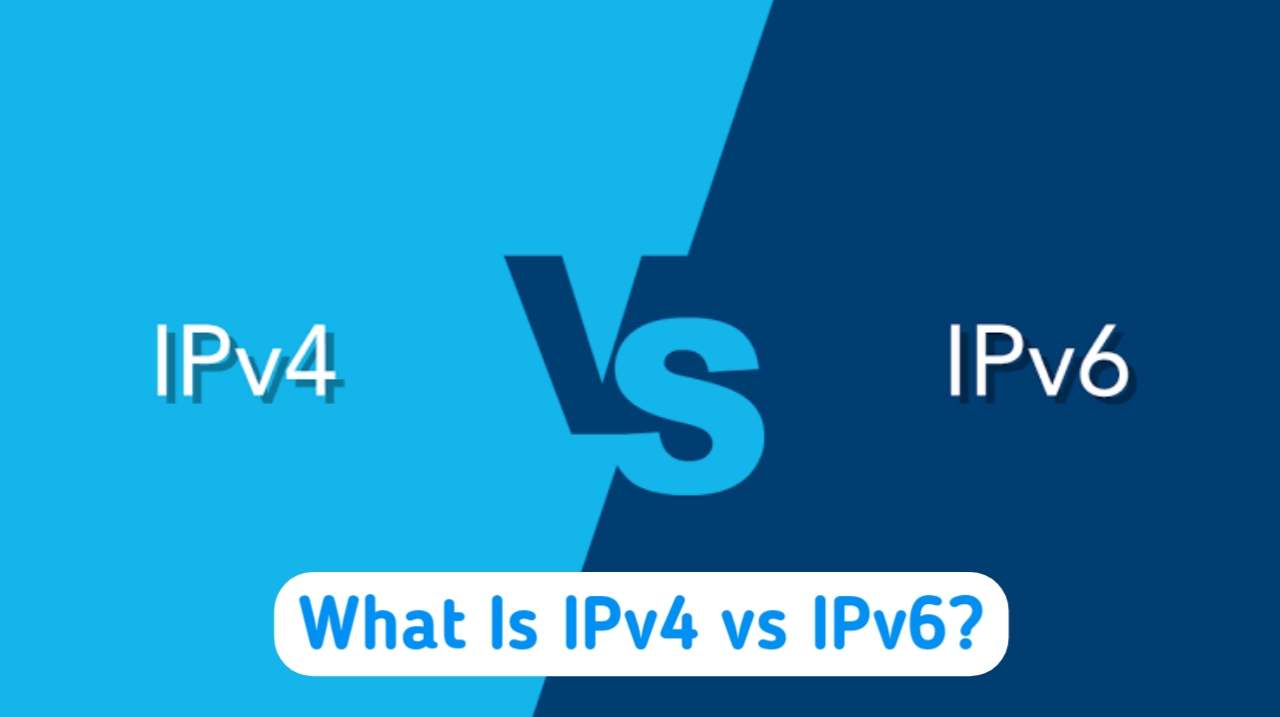
Have you ever heard of IPv4 or IPv6? How would you feel after hearing that the Internet is now passing through the constraints of Internet Addresses? You must have also heard that the last block of IPv4 Internet Address has also been allocated now.
If you have guessed by now, let me make it clear to you that I am talking about the underlying technology that drives the Internet Protocol address. Yes, it is called IP Address. Which is associated with the beginning of the Internet and is going to end very soon. We are now concerned about this issue.
IPv6 often referred to as the successor of IPv4, will soon take its place. IPv6 has many advantages over IPv4. With this new technology, not only will we get more numerical addresses, but its use will also make address assignment and network security much easier. But the transition from IPv4 to IPv6 can be a bit daunting and challenging.
People have no idea about these two techniques. So today I thought why not give complete information about IPv4 and IPv6 to you guys so that you can get to know about the difference between IPv4 and IPv6 properly? First of all, let us know what is Internet Protocol.
What is Internet Protocol (IP)?
The full form of IP is Internet Protocol. It describes the technical formats of how data packets are processed and how computers in the network communicate with the help of addressing schemes.
Almost all networks combine IP with a high-level protocol, also known as a Transmission Control Protocol (TCP), to create a virtual connection between the destination and the source.
If I explain to you with an example, you will probably understand more. IP is like our Indian postal system in which this package (datagram) is first sent to the address (encapsulation) and then it is sent by a sender to the system (Internet). But there is no direct connection between sender and receiver.
That package (datagram) is divided into several parts, but the address of the receiver (destination host) remains in all parts. And over time each part reaches the receiver, but on different paths and at different times.
It determines the route and time by the postal system, here called IP. But the postal system (here the transport and application layers) links all the parts together and delivers it to the receiver (destination host) at the right time.
Whereas in TCP/IP a connection is established between two hosts so that they can exchange messages among themselves for a period of time.
What is an Internet Protocol Version?
A current example of Internet Protocol is IPv6. IPv6 is an evolution of IP version 4, and is the latest version. In extreme situations where IPv6 is in high demand, IPv6 will coexist with the older IPv4 for some time.
What is IPv4?
IPv4 (Internet Protocol Version 4) It is the fourth revision of Internet Protocol (IP) and is used to identify the device through the addressing system in the network.
Internet Protocol is designed to be used in interconnected systems of packet-switched computer communication networks.
IPv4 is commonly used to connect devices to the Internet in accordance with the Internet Protocol. IPv4 uses a 32-bit address scheme that allows 2^32 addresses (and has about 4 billion addresses).
But as the Internet is growing, it is estimated that gradually all IPV4 addresses will be lost because today they are being used in all devices like computers, smartphones, and game consoles, and all these devices are connected to the Internet. Huh. An address is required to join together.
What is IPv6?
To meet these shortcomings of IPv4, a new Internet addressing system has been introduced and it is known as Internet Protocol Version 6 (IPv6) and it can prove to be helpful in filling the shortfall of Internet Addresses.
IPv6 (Internet Protocol version 6) is also called IPng (Internet Protocol next generation) and is the new version of Internet Protocol (IP). IETF standards committees have been used to review it so that it can completely replace IPv4 (Internet Protocol Version 4).
IPv6 is considered the successor to Internet Protocol Version 4 (IPv4). It is specifically designed to be an improved version of the Mehjuda Internet Protocol so that it can co-exist with IPv4 for some time.
IPv6 is designed to help the Internet grow steadily, allowing the number of connected hosts and the full amount of data traffic transmitted to grow properly.
Known as the “next generation” Internet standard and developed since the late 1990s, IPv6 is the latest version of the Internet protocol. IPv6 was created because people felt that the way demand for IP addresses is increasing, the day is not far when IP addresses will be completely eliminated.
Benefits of IPv6
Although IPv6 will help a lot in increasing the pool of addresses and it is being discussed more among the people, along with this there are many other technical changes in IPv6 that make IP Protocol more important.
- No need to do NAT (Network Address Translation)
- Auto-configuration
- Private address collisions won’t happen anymore
- Having better multicast routing
- Simpler header format
- Simplified, more efficient routing
- Flow labels, or quality of service (QoS), are ways to measure the quality of service.
- Built-in authentication और privacy support
- Flexible options और extensions
- Easier administration (no more DHCP required)
How does IPv4 and IPv6 work?
- IPv4 uses 32 bits long (4 bytes) of addresses, while IPv6 uses 128 bits of addresses separated by 8 16-bit hexadecimal blocks. The colon is used to divide. For example, 2dfc:0:0:0:0217:cbff:fe8c:0.
- IPv4 addresses are divided into “classes”, with some being Class A networks for large networks, Class C networks for thousands of smaller networks, and Class B networks in between. Subnetting is used in IPv6 to adjust the network size and also give a specific address location assignment.
- Uses IPv4 class-type address space to multicast (224.0.0.0/4). Whereas IPv6 uses the unified address space at FF00::/8 for multicast.
- IPv4 uses a “broadcast” address to force each device to shut down and watch the packets. Whereas IPv6 uses multicast groups.
- IPv4 uses 0.0.0.0 to represent an unspecified address and a class-type address (127.0.0.1) for loopback. But IPv6 uses :: and : 1 for unspecified and loopback addresses.
- Uses globally unique public addresses for IPv4 traffic and “private” addresses. Whereas IPv6 uses globally unique unicast addresses and local addresses (FD00::/8).
Difference between IPv4 और IPv6
| IPv4 | IPv6 |
| Packet size: 576 bytes required and fragmentation optional | Packet size: 1280 bytes required होता है और without fragmentation |
| Packet fragmentation: Routers and sending hosts | Packet fragmentation: Sending hosts only |
| There is not much security in IPv4 because IPv4 was never designed from the point of view of security. | |
| – It was originally designed for isolated military network | |
| After that, it was adapted for public education and research network | IPv6 was built with strong security from the beginning, and along with its – Encryption – Authentication facility was also provided. |
| There are 13 fields in the IPv4 header and it has 20 bytes. | IPv6 header is just double because it contains 40 bytes and IPv6 header has fewer fields like 8 fields. |
| ISP has IPv4 connectivity or both IPv4 and IPv6 connectivity | Whereas many ISPs do not have IPv6 connectivity. |
| It has a non-equal geographical distribution (>50% USA) | It does not have any geographic limitation |
Why are IPv4 addresses going to expire?
IPv4 uses 32 bits for its Internet address. This means it can support a total of 2^32 IP addresses – which is around 4.29 billion.
This may sound like a lot, but today almost all 4.29 billion IP addresses have been given to various institutions, due to which there can be a shortage of IP addresses in the coming time. Keeping this situation in mind, IPv6 is being introduced as soon as possible.
How will IPv6 solve this problem?
As I have said earlier, IPv6 uses 128-bit Internet addresses. Hence it can support approximately 2^128 Internet addresses – 340, 282, 366, 920, 938, 000, 000, 000, 0,000,000 if we talk about its exact value.
And these are actually a lot of addresses compared to IPv4. There are so many addresses that we have to use the hexadecimal system to display these addresses. Or say that there are so many addresses in IPv6 that the Internet can be kept running for a long time.
So why can’t we switch directly?
It is as if the end of IPv4 addresses was predicted years ago, leading to the progress of switching from the past decade itself. But this work cannot be done in haste, so this work is going on slowly.
With this, both IPv4 and IPv6 run simultaneously in parallel networks – and data exchange between the two requires a special gateway.
And to make this kind of switch the software and also the router would have to be changed so that it is a more advanced network.
And making such a switch would also require changing the software and routers so that they can support more advanced networks. It requires both time and money. Therefore, this process cannot be done directly, but it can be changed gradually.
How will this change affect you?
In the beginning, it may not make a big impact on our lives. Today, virtually all modern devices and operating systems support IPv6. But there are still many routers and servers that don’t support them, making it very difficult to connect to devices and the Internet.
IPv6 is still in its early stages, with many bugs and security issues. And these problems have to be fixed in order to work properly, otherwise, there may be a bigger problem in the future.
No one has any idea about the cost and time involved in this change, but scientists say that this change may take some more time.
The future of IPv6
With the change in IPv6, a lot of changes can be seen in the coming time. Because of the problem of IP address, if we talk about network security, then IP is going to be even better everywhere. Many more devices can be connected simultaneously with the help of multiple addresses.
The facility of mobility and multihoming can also be seen. Mobility means moving from one network to another without changing the IP address. By the way, multihoming means connecting to more than one ISP at a time so that even if there is some problem in any connection, it can be easily transferred to another connection. Many such changes can be seen in the coming time.
Conclusion:-
I sincerely hope that I have given you complete information about what is IPv4 and IPv6 and I hope you guys have understood IPv4 and IPv6. My request to all of you readers is that you also share this information with your neighbors, relatives, your friends, which will bring awareness to us and it will benefit everyone a lot. I need your cooperation so that I can pass on more new information to you guys.
It has always been my endeavor that I always help my readers or readers from all sides, if you people have any kind of doubt, then you can feel free to ask me.
I will definitely try to clear those doubts. How did you like this article IPv4 and IPv6, do tell us by commenting so that we too get a chance to learn something from your thoughts and improve something.
If you have read our article completely, then by now you must have got all this information and you must have got the answer to your question, which you came to our blog while searching.
So how did you like today’s post, do tell us by commenting and subscribing to the email newsletter to get more such posts in the future.







